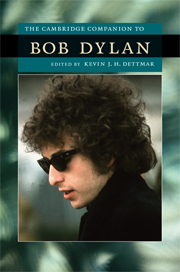Book contents
- Frontmatter
- Introduction
- Part I Perspectives
- 1 Bob Dylan and the Anglo-American tradition
- 2 Bob Dylan and Rolling Thunder
- 3 Bob Dylan as songwriter
- 4 Bob Dylan as performer
- 5 Bob Dylan and collaboration
- 6 Bob Dylan and gender politics
- 7 Bob Dylan and religion
- 8 Bob Dylan and the Academy
- 9 Bob Dylan as cultural icon
- Part II Landmark Albums
- Works cited
- Index
7 - Bob Dylan and religion
from Part I - Perspectives
Published online by Cambridge University Press: 28 May 2009
- Frontmatter
- Introduction
- Part I Perspectives
- 1 Bob Dylan and the Anglo-American tradition
- 2 Bob Dylan and Rolling Thunder
- 3 Bob Dylan as songwriter
- 4 Bob Dylan as performer
- 5 Bob Dylan and collaboration
- 6 Bob Dylan and gender politics
- 7 Bob Dylan and religion
- 8 Bob Dylan and the Academy
- 9 Bob Dylan as cultural icon
- Part II Landmark Albums
- Works cited
- Index
Summary
By the late 1970s Bob Dylan had made his Christian turn, and many who had been accustomed to claiming him as free-thinking protest singer and prophet of modern peace felt betrayed. Among them was the music critic Michael Goldberg. Writing for the New Musical Express, Goldberg decried the sudden simplicity of Dylan's view of the world, comparing it to the beliefs of cultists who had gained so much attention throughout the 1970s. “Where are the de-programmers when we really need them?” he asked. Not lost on Dylan was the irony that many of his staunchest critics were former devotees, people who'd responded to the secular verve of his music in a religious spirit, tapping him as their very own social prophet (see Marcus, “Amazing”). At a 1979 concert during the tour for Slow Train Coming, his first album of gospel music, Dylan remembered how his critics had tried for years to tell him he was a prophet and overridden all his objections to the contrary, until one day he'd come around and declared Christ to be the answer - whereupon they turned on him, saying, “Bob Dylan's no prophet.” A great many admirers found themselves excluded by the line Dylan was drawing between those with faith and those without, but in fact he'd always been drawing lines, many of them based on his loose and ever-changing concept of faith. Dylan's turn to evangelical Christianity is one of the two most controversial episodes of the singer's sometimes infamous, often legendary biography; the other is his so-called rejection of the folk movement on the July day when Dylan went electric at the 1965 Newport Folk Festival and got booed for his troubles. What connects the two is conversion: in the first case a transition in musical style perceived as an ideological rift, in the second a revolution in personal consciousness perceived by many as having deleterious effects on his music. Nowadays most Dylanologists view his “Christian phase” as but one more example of Dylan's brilliant eccentricity.
- Type
- Chapter
- Information
- The Cambridge Companion to Bob Dylan , pp. 87 - 99Publisher: Cambridge University PressPrint publication year: 2009
- 1
- Cited by



